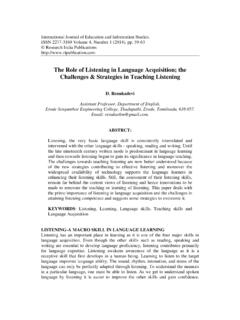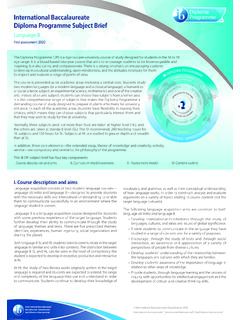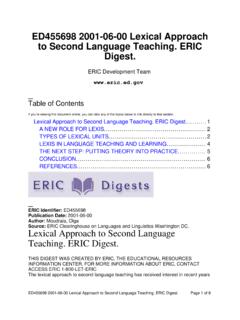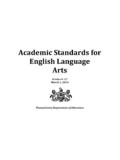Transcription of What Is Listening Comprehension and What Does It Take to ...
1 1 What Is Listening Comprehension and What Does It Take to Improve Listening Comprehension ? Young-Suk Grace Kim and Heather Pilcher Kim, G., & Pilcher, H. (2016). What is Listening Comprehension and what does it take to improve Listening Comprehension ? In R. Schiff & M. Joshi (Eds.), Handbook of interventions in learning disabilities (pp. 159-174). New York: Springer. 2 Abstract One s ability to listen and comprehend spoken language of multiple utterances ( , Listening Comprehension ) is one of the necessary component skills in reading and writing development. In this chapter, we review theoretical frameworks and empirical evidence of Listening Comprehension development and improvement, and propose a direct and mediated model of Listening Comprehension .
2 A review of correlational and intervention studies indicates that many language and cognitive skills contribute to Listening Comprehension , including working memory, attention, vocabulary, syntactic knowledge, inferencing, theory of mind, and Comprehension monitoring. Although limited in number, studies indicate that these skills are malleable. We conclude that Listening Comprehension instruction should be an integral part of reading and writing instruction, incorporating these multiple language and cognitive skills. Instruction on these components can be incorporated into existing instruction such as bookreading or reading Comprehension instruction. Keywords: Listening Comprehension , vocabulary, language , cognitive, intervention, reading Comprehension , writing 3 Introduction The role of oral language in literacy development is unquestionable in terms of theory and empirical evidence.
3 Oral language , however, is a broad construct encompassing lexical, sentence, and discourse-level skills. A lexical-level oral language skill, vocabulary, has received much attention in terms of theoretical models of reading ( , Perfetti, 2007), and empirical studies (see Chapter 5). In contrast, our understanding of Listening Comprehension has been limited. Recent emerging evidence, however, indicates that Listening Comprehension is a higher-order skill that requires multiple language (including vocabulary) and cognitive skills ( Florit, Roch, & Levorato, 2013; Kim, in press; Kim & Phillips, 2014; Lepola, Lynch, Laakkonen, Silven, & Niemi, 2012; Tompkins, Guo, & Justice, 2013). In this chapter, Listening Comprehension is defined as one s ability to comprehend spoken language1 at the discourse level including conversations, stories ( , narratives), and informational oral texts that involves the processes of extracting and constructing meaning.
4 In this chapter, we review the role of Listening Comprehension in literacy acquisition, theories of text Comprehension , and empirical studies. We close the chapter with a summary of instructional approaches to improve Listening Comprehension based on a review of empirical studies. Why Listening Comprehension for Reading and Writing Development? One of the widely supported models of reading Comprehension , the simple view of reading, specifies that linguistic Comprehension is an essential skill in addition to decoding (or word reading proficiency) (Gough & Hoover, 1990). Much evidence has provided support for the simple view of reading in several languages (Catts, Adlof, Ellis Weismer, 2006; Johnston & Kirby, 2006; Joshi & Aaron, 2000; Joshi, Tao, Aaron, & Quiroz, 2012; Kendeou, van den Broek, 1 We acknowledge that Comprehension of sign language is Listening Comprehension , but use spoken language following conventional use of the term.)
5 4 White, & Lynch, 2009; Kim, 2015a; Protopapas, Mousaki, Sideridis, Kotsolakou, & Simos, 2013), and showed that oral language skills such as vocabulary and Listening Comprehension are critical to reading Comprehension , and their importance increases as children develop reading skills (Foorman, Koon, Petscher, Mitchell, & Truckenmiller, 2015; Kim, 2015b; Kim, Wagner, & Lopez, 2012; Kim & Wagner, 2015). Despite its recognized importance, however, what it takes to develop Listening Comprehension has been nebulous, which is in stark contrast to our understanding about skills that contribute to word reading (see Adams, 1990; Bowey, 2005; National Early Literacy Panel R eport, 2008). Note that a ccording to Gough and Tunmer (1986), linguistic Comprehension is the process by which given lexical ( , word) information, sentences and discourses are interpreted (p.
6 7), and thus includes lexical, sentence, and discourse skills ( , Listening Comprehension ). Oral language skills including Listening Comprehension are also important for writing development. Although oral language skills are not explicitly specified in the developmental models of writing ( , written composition; but see Kim & Schatschneider, in review), they are nonetheless essential component skills as w riting requires generation of ideas, which then need to be translated into oral language at the lexical, sentence, and discourse levels (Berninger et al., 2002). According to the simple view of writing, transcription and ideation are two necessary skills for writing (Juel, Gough, & Griffin, 1986). The ideation component includes generation and translation of ideas, and thus implicates oral language skills.
7 Similarly, oral language is implicated in the text generation component of the not-so-simple view of writing (Berninger & Amtmann, 2006). Empirical studies have indeed shown the importance of oral language , operationalized as sentence Comprehension (Berninger & Abbott, 2010), vocabulary, syntactic knowledge (Kim et al., 2011, 2014; Olinghouse, 2008), and Listening Comprehension (Kim, Al 5 Otaiba, Wanzek, & Gatlin, 2015). Oral language is particularly important to the quality aspect of writing (idea and organization) relative to productivity (amount of writing; Kim, 2014; Kim et al., 2014, 2015; Olinghouse, 2008). These indicate that children s oral language skills, including Listening Comprehension , facilitate the expression of ideas in an appropriate and rich way in their writing.
8 In summary, theoretical models of reading Comprehension and writing as well as empirical evidence indicate the importance of oral language skills, including Listening Comprehension , in reading and writing development. One naturally rising question, then, is what it takes to develop Listening Comprehension . Theoretical Models of Listening Comprehension In order to understand what it takes to develop and improve Listening Comprehension , we need to know what component skills contribute to Listening Comprehension . Theoretical models of text Comprehension are relevant here as text Comprehension includes Comprehension of oral and written texts ( , Listening and reading; Kintsch, 1988) although text Comprehension has been mostly examined in the context of reading Comprehension .
9 There are several models of text Comprehension . Although there are differences, at the center of these models is the situation model (Graesser et al., 1994; van Dijk & Kintsch, 1983). That is, successful text Comprehension ultimately requires construction of the situation model (Graesser et al., 1994; Graesser, Millis, & Zwaan, 1997; van Dijk & Kintsch, 1983) or the mental model (Johnson-Laird, 1983). The situation model is the mental representation of what a text is about (Kintsch, 1988) or the microworld that the text is about (Graesser et al., 1997, p. 167), and includes representation of multiple aspects such as space, time, causation, intentionality (or goals), and characters and objects (Graesser et al., 1994; Zwaan & Radvansky, 1998).
10 Below is a description of a few 6 prominent models of text Comprehension : the construction-integration model, the constructionist model, and the landscape model. The construction-integration model was proposed and refined by Kintsch and his colleagues (van Dijk & Kintsch, 1983; Kintsch, 1988, 1998, 2005). As the name indicates, this model hypothesizes that text Comprehension involves two phases, construction and integration of propositions. The comprehender constructs initial elementary propositions based on words and sentences in the text. T hese initial propositions, then, have to be integrated with propositions from preceding parts of the text, and ultimately across the text and with background knowledge. Based on these two phases of processing, the following three hierarchical levels of mental representations2 have been hypothesized with consensus among researchers (Kintsch, 1988; Graesser, Millis, & Zwaan, 1997): surface code, textbase, and situation model.
















